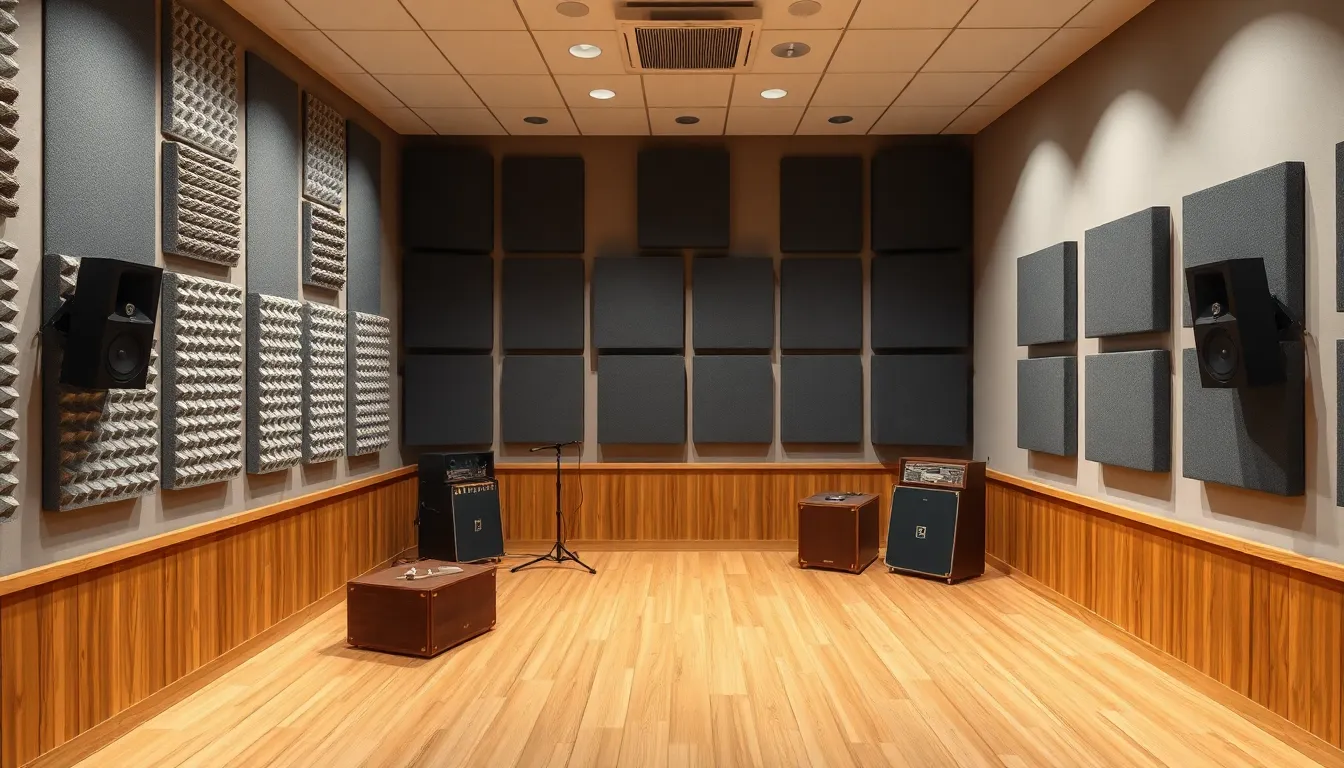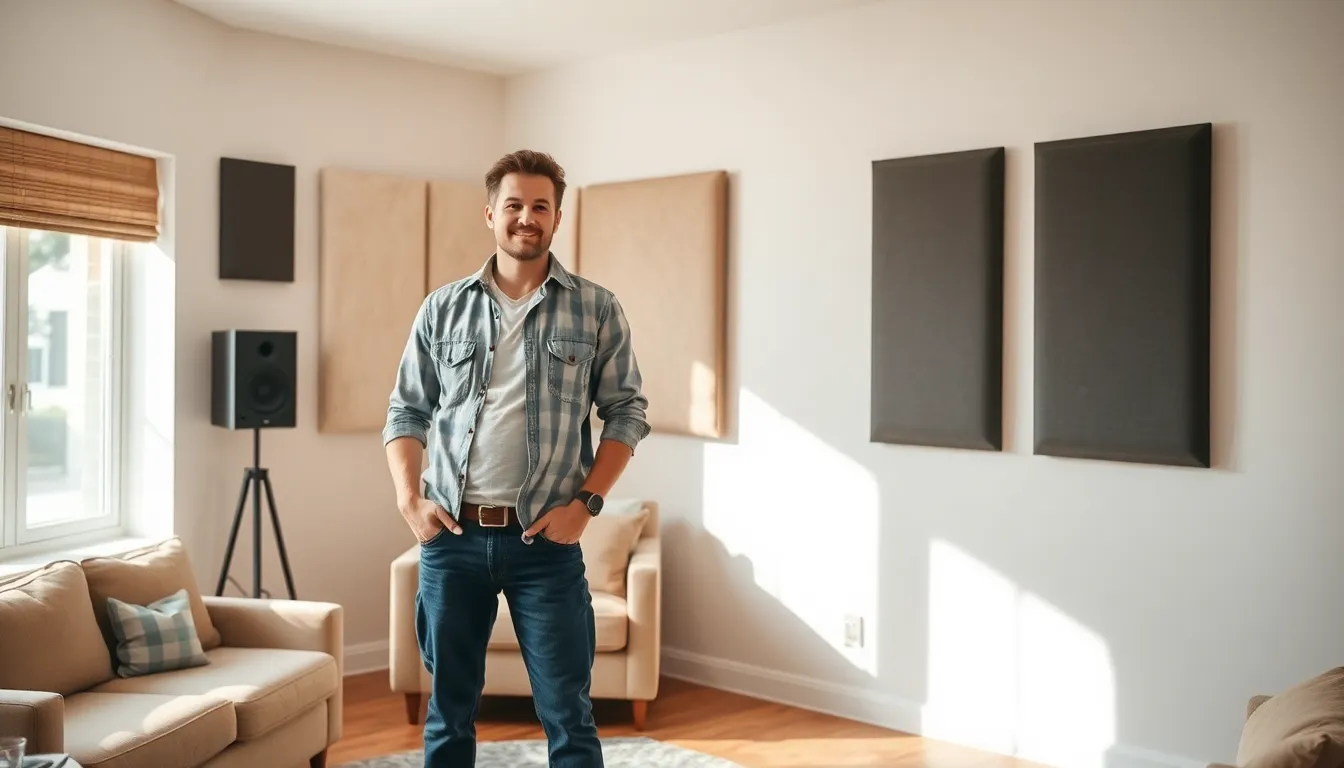Imagine stepping into a room where every sound feels just right—like a perfectly brewed cup of coffee on a Monday morning. That’s the magic of acoustic treatment. It’s not just for recording studios or concert halls; it’s for anyone who wants to elevate their listening experience, whether it’s for music, movies, or even those epic podcast marathons.
Table of Contents
ToggleUnderstanding Acoustic Treatment
Acoustic treatment enhances sound quality in various environments, including homes, offices, and studios. Such treatment addresses sound issues for improved listening experiences.
What Is Acoustic Treatment?
Acoustic treatment involves employing materials to manage sound reflections, absorption, and diffusion. These methods create an optimal listening environment by reducing echo and controlling background noise. Common materials used include acoustic panels, bass traps, and diffusers, each serving specific purposes. Acoustic panels absorb high-frequency sounds, while bass traps target low frequencies. Using a proper combination of these treatments ensures a balanced sound.
Importance of Acoustic Treatment
Acoustic treatment plays a crucial role in sound clarity and overall audio quality. Enhancing speech intelligibility affects communication in meetings and presentations. Improved sound quality elevates the listening experience during music, movies, or podcasts. Untreated spaces often lead to sound distortion, making it hard to enjoy audio content. Investing in acoustic treatment minimizes these issues, thus optimizing sound quality for all users.
Types of Acoustic Treatment

Acoustic treatment encompasses various types of materials designed to enhance sound quality in different environments. Key options include absorption panels, diffusion panels, and bass traps.
Absorption Panels
Absorption panels reduce sound reflections by soaking up sound energy. They consist of materials like foam or fiberglass, effectively minimizing echoes and improving clarity. Installing these panels on walls or ceilings transforms any room into a more pleasant listening space. They work well in recording studios, home theaters, and even conference rooms. By focusing on specific frequencies, absorption panels can target problematic sound areas, creating a balanced audio environment.
Diffusion Panels
Diffusion panels scatter sound waves, preventing them from clashing and causing distortion. These panels consist of irregularly shaped surfaces that break up sound reflections. Placing diffusion panels strategically in a room creates a more spacious and natural sound. Musicians and audio engineers often use these panels to improve recordings and live sound. They also help maintain a lively acoustic feel while still controlling any problematic echoes.
Bass Traps
Bass traps manage low-frequency sounds, which are often harder to control than higher frequencies. Made from dense materials, these traps are typically placed in corners where bass build-up occurs. Effective bass traps absorb excess low frequencies, minimizing muddiness in sound. Adding bass traps to a space enhances overall audio clarity and responsiveness. They prove essential for music production, home theaters, and any environment with heavy bass sounds.
How to Choose the Right Acoustic Treatment
Selecting the appropriate acoustic treatment involves assessing a few key factors. An understanding of room characteristics and sound issues helps determine the best materials for the space.
Room Size and Shape
Room dimensions play a significant role in determining acoustic treatment needs. Smaller rooms may benefit from absorption panels to control sound reflections. Larger spaces might require a combination of diffusers and bass traps to manage low frequencies effectively. Irregularly shaped rooms often pose additional challenges, necessitating custom solutions for optimal results. Analyzing the size and geometry establishes a foundation for selecting the right acoustic products.
Specific Sound Issues
Identifying unique sound problems is crucial for effective acoustic treatment. Issues such as excessive echo or booming bass indicate different treatment requirements. Echo may call for additional absorption panels, while bass issues demand robust bass traps. Understanding specific needs guides the selection process, ensuring that treatment effectively addresses distinct sound challenges. Prioritizing sound issues leads to targeted solutions, enhancing overall audio clarity.
Installation and Setup
Effective installation of acoustic treatment significantly enhances sound quality. Proper setup maximizes the benefits of treatment materials.
DIY Acoustic Treatment
Creating DIY acoustic treatment can be cost-effective and rewarding. Begin with assessing room characteristics to understand specific needs. Use absorption panels for small spaces to reduce sound reflections. Building bass traps involves simple construction techniques using materials like mineral wool or foam. When crafting diffusers, consider using wooden frames for aesthetic appeal alongside functionality. Materials such as carpet or heavy curtains can also aid in dampening sound at lower costs. For optimal placement, install panels at reflection points around speakers and listening areas. Engaging in this project fosters a better grasp of acoustic properties while improving personal spaces.
Professional Installation
Seeking professional installation offers precision and expertise. Professionals assess room acoustics thoroughly, ensuring appropriate treatment types are selected. They bring experience in positioning treatment materials for maximum effectiveness. Adjusting treatment according to specific sound issues, like echo control or bass management, ensures tailored solutions. This method guarantees optimal sound clarity and reduces distortion significantly. Hiring an expert may involve a higher initial investment but results in long-term improvements in sound quality. Ultimately, professional services offer reassurance that installations meet industry standards and expectations.
Investing in acoustic treatment is a game changer for anyone wanting to elevate their audio experience. Whether in a home theater or a professional studio effective treatment can drastically improve sound clarity and reduce unwanted noise. By understanding the unique characteristics of their space and the specific sound challenges they face individuals can make informed choices about the right materials and installation methods.
DIY options offer a budget-friendly path while professional installation ensures precision and adherence to high standards. Regardless of the approach chosen the benefits of acoustic treatment are undeniable. Embracing this practice not only enhances enjoyment but also transforms any environment into an optimal listening space.




